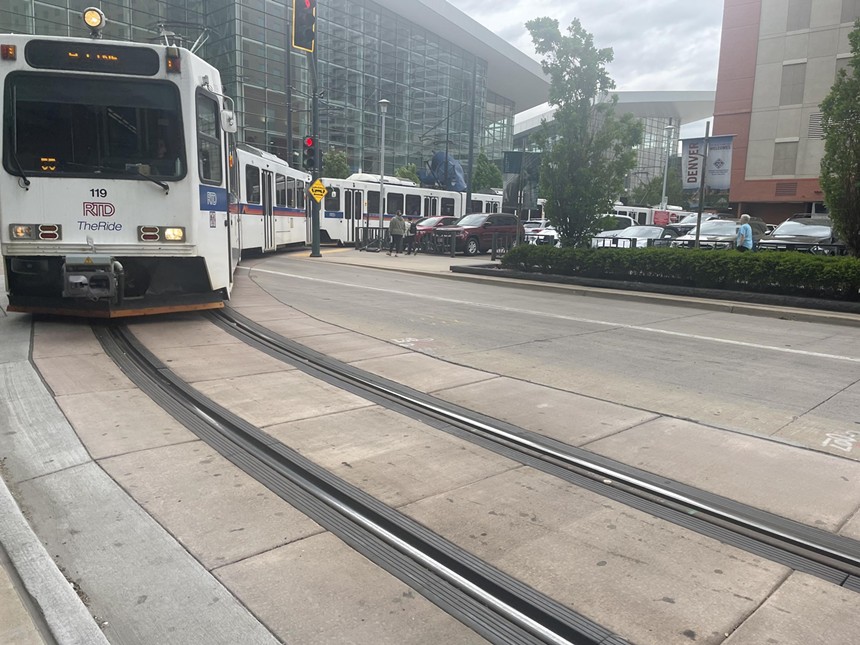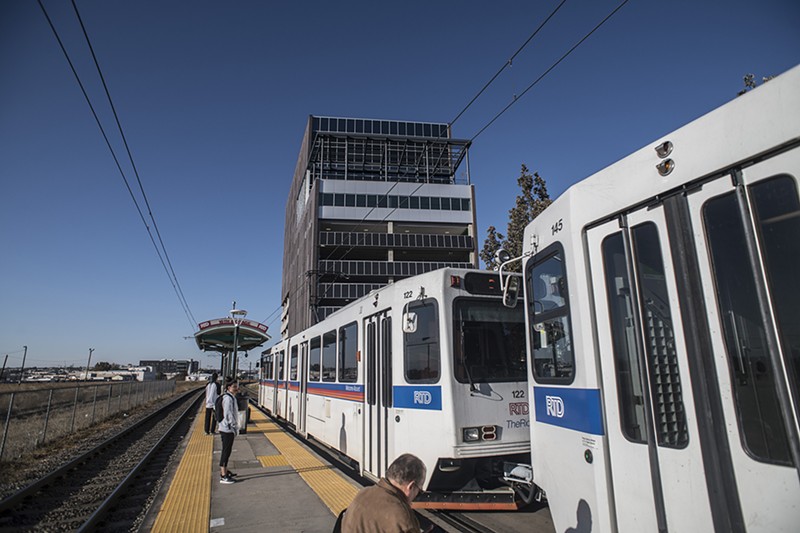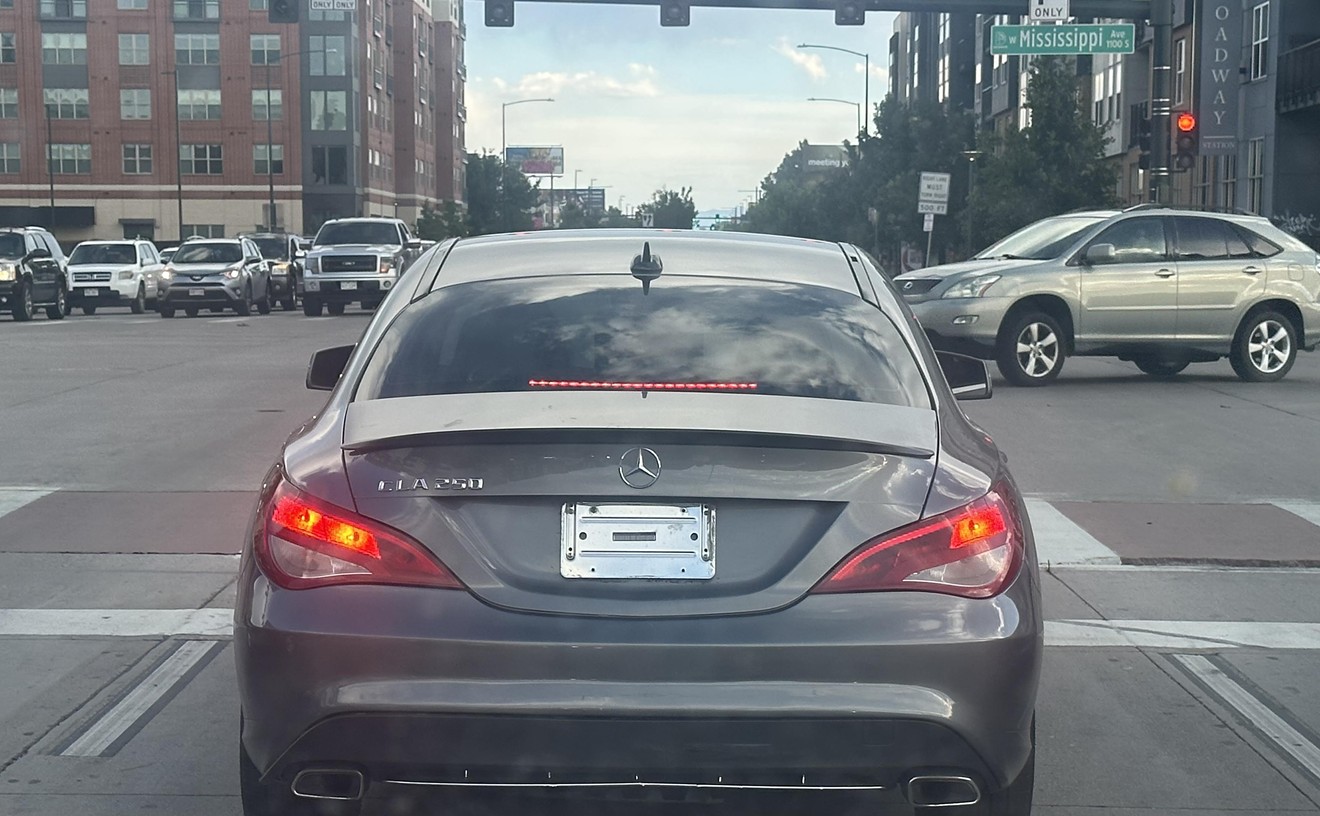“We're now in a situation where there’s an absolute catalogue of failures,” says Richard Bamber, co-founder of Greater Denver Transit, an advocacy group focused on providing technical expertise to urban public transit discussions around the city. “From a safety standpoint, we're finding out that the things that should be done under the hood with the agency are not happening correctly, and that the product for riders is unacceptable at the moment.”
RTD’s southeast rail corridor comprises twenty miles of track along Interstate 25, from Lone Tree to Denver, and includes portions of the E, H and R lines. In early June, RTD implemented two slowdown zones where trains can only go 10 miles per hour after identifying potential safety issues that need immediate attention.
At the same time, the district is completing coping panel maintenance, leaving a single track for trains in the southeast corridor this summer. That was also the case last summer, when Westword documented the fiasco of people attempting to access the light rail after a Weezer concert at Fiddler’s Green Amphitheatre.
This summer, the downtown rail reconstruction project is adding to light rail woes, as most routes have been redirected to Union Station, and the coping panels project has once again decreased the number of trains on the southeast corridor to accommodate single tracking. Now, trains are supposed to run every sixty minutes on the E and H lines, barring any other delays.
“Light rail is supposed to be fast and frequent, so to run a train every sixty minutes...it's a joke,” Bamber says.
According to GDT, unpredictable trains have contributed to RTD’s stalling ridership recovery since the pandemic; the organization predicts the loss of rail ridership will outlast these maintenance projects. And while bus ridership is improving right now, rail ridership is not, with the E and H lines both losing over 5 percent of their riders this March compared to March 2023, GDT data analysis shows.
"It's a permanent change in behavior when transit is unusable,” says James Flattum, GDT’s co-founder. “The longer that RTD takes to get its act together, the more people they're going to lose out on.”
Public Utilities Commission Calls Out Rail Safety Concerns
The safety efforts that have caused slowdowns this summer date back to 2022, when RTD crews found the rail line at 19th and Stout streets was so hazardous it was condemned and had to be repaired under emergency conditions.Because of that event, the Colorado Public Utilities Commission — which regulates RTD — ordered the agency to examine what went wrong while also changing procedures to prevent future rail condemnation. RTD updated its procedures last March with a plan to implement a strategy for tracking the conditions of light rail lines.
“RTD proactively adopted an enhanced inspection methodology to improve its ability to manage assets and plan for large-scale renewal and reconstruction efforts,” RTD spokesperson Tina Jaquez says. “Trained staff now ride the system twice weekly and walk it every ninety days to take additional measurements and carefully document anomalies found.”
According to RTD, the southeast corridor’s inspections this spring followed a PUC-approved plan that includes implementing speed restrictions when needed. But GDT argues that the slowdowns, combined with the other disruptions, have rendered the E and H lines unusable, particularly because of a lack of communication with the public.
The PUC believes it has been left out of the loop, too, according to a June 14 letter sent to RTD General Manager and CEO Debra Johnson by PUC Director Rebecca White on June 14.
“RTD’s implementation of this final corrective action led to the identification of issues in track conditions along the SE Corridor,” White wrote. “The PUC was not notified of these findings along the SE Line nor the issuance of a slow order but rather learned of this development through media inquiries.”

This replacement outside the Colorado Convention Center is what light rail tracks are meant to look like.
Catie Cheshire
The letter asks RTD to provide the PUC with safety inspection results for the corridor for the entirety of 2024, updates to the repair schedule every 48 hours until repairs are complete, and a schedule for completing similar inspections on RTD’s other light rail lines into the future. The PUC is also asking RTD to update its list of prioritized investments to include unaddressed rail safety conditions.
RTD says it is working to compile the requested information.
“Lastly, the PUC advises that RTD continue to increase its transparency to the public on its efforts to improve rail conditions and return service to normal operations,” White’s letter concludes. “As stated in RTD’s Public Transportation Agency Safety Plan, ‘Customers and the general public must be confident that the RTD transit system is a safe system.’ Recent events have shaken that confidence along the SE Corridor.”
GDT couldn’t agree more, which is why the organization followed up with a letter of its own to Johnson on June 19 asking for more specifics about the technical side of the problem and the perceived public-outreach failures.
Riders "Fed Up" With RTD Delays
Bamber says the E Line is often delayed by more than twenty minutes right now and service alerts aren’t providing enough information to riders. As of Thursday, June 20, the E Line service alert says delays of up to 45 minutes are expected “until further notice.” “What we've heard from the rider perspective is 'We're fed up with this,'” Bamber says. “We call immediately for them to start putting in a schedule that works.”
By July 3, GDT wants RTD to share when track inspection standards were adopted. The group also asks RTD to clarify how it determines when slow zones are required in the inspection process.
GDT wants to know if RTD could have predicted the “widespread imposition” of slowdowns stemming from the new track inspection standards; the group has also inquired about particular solutions to the identified problem of railhead burn, which is damage to the top of a track from friction.

An example of railhead burn, a safety issue causing slowdowns on light rail.
RTD RTD
RTD says staff is reviewing those questions, noting that many of the topics addressed by GDT are covered on its speed restrictions web page, which RTD plans to update with responses.
GDT also proposed six remedial measures from RTD. Suggestions include working with the RTD operators' union to publish workable, temporary schedules for the E, H and R lines that can be revised weekly. Additionally, it asks for bus bridges up and down Interstate 25 to minimize adverse impacts of rail delays.
“It's not just riders that are really feeling this. It's operators,” Flattum says. “We've gotten reports that operators are absolutely being strained. … RTD has not published a new schedule that's compatible with all this work. They're not getting breaks.”
While RTD has made progress on filling out its bus operator workforce, it lost rail operators in the last year, Flattum adds. The other GDT action items ask RTD to publish a schedule of remaining inspections in this quarter and commit to 100 percent transparency with the public by “publishing all light rail-related incidents, inspection and remedial works going forward.”
“It’s not proactive with its regulators,” Bamber argues. “It's certainly not proactive with its general public in telling us in advance, or even in a timely manner, when there are issues. We learn about it when it's developed into a full-blown crisis problem. … We can't go on this way. The reason I say that is history sadly tells you that when transit agencies, railroad operators, have carried on this way, we have a big one and we kill a lot of people.”
RTD plans to provide a maintenance update on June 21 that will include the upcoming maintenance schedule.












